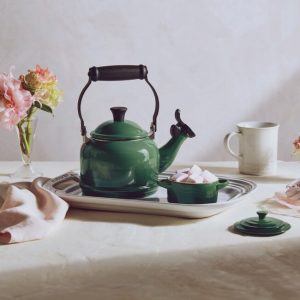
If your favorite morning cup of tea has been tasting a bit off lately, the reason for that might be your tea kettle. The water you heat up inside, whether it is for tea, coffee, soups, or boiling, leaves minerals that get trapped inside the kettle. Those mineral deposits can affect the taste of your drinks or food and they even have a name – kettle furring. Gross, huh?
Fortunately for you, cleaning a kettle is easy and you will be able to achieve wonderful results by using simple ingredients that can be found in most kitchens. Keep reading to find out how to get rid of the mineral deposits, and the nasty buildup, as well as how to maintain your stovetop kettle clean for longer.
How often do stovetop kettles need to be cleaned?
That depends on a few things. First, how often do you use your kettle? If you use it daily, you may need to clean it a bit more often than if you only put it on the stove once a week. The other important thing you should take into consideration is the water in your house. If you live in an area with hard water, cleaning will be needed as soon as you notice the furring.
Ideally, you should empty your kettle after every use, or at the end of the day if you are using it multiple times a day. Wipe down the exterior once a day or whenever splatters occur. That way you will keep stains and fingerprints at bay.
Usually, kettles need to be cleaned once every 3-4 months. However, if your water is hard, you may want to do this once a month.
How to clean your stovetop kettle?
1. Descaling the interior – Fill the kettle with a solution of 1:1 water and white distilled vinegar or lemon juice. Put the kettle on the stove, bring it to a boil, remove it, and let it sit with the liquid inside for 20-30 minutes. The acidic nature of the vinegar/lemon juice will dissolve the mineral deposits, making the cleaning process much easier.
2. Remove mineral deposits – To remove the mineral buildup from the inside of the kettle, use a soft-bristled brush or a sponge to scrub away any residue that is left inside. If there is any stubborn buildup, dip the sponge or brush in pure vinegar to help dislodge any hard-to-reach areas like around the opening and the edges of the lid.
3. Cleaning the exterior of your kettle – For the exterior, use warm water and a few drops of dishwashing liquid. Use a sponge to scrub away any grime on the outside of your kettle. If there are any greasy stains or splatters, dip the sponge in baking soda and gently scrub them. Rinse the kettle well.
4. Rinse – Fill the kettle with pure water, bring it to a boil and pour it out. That way you will be able to get rid of any remaining cleaning solution and grime.
Extra tip: If you are cleaning a tarnished copper stovetop kettle, cut a lemon in half, dip it in salt and gently rub it all over the surface. That will bring your kettle back to its beautiful shine. Rinse thoroughly, then dry with a lint-free clean cloth.
How to clean a burnt stovetop kettle
If you forgot your kettle on the stove and now its bottom is burned, follow these steps to get rid of the grime.
1. Soak the kettle – Fill a tub or a sink with hot water and add some degreasing dishwashing liquid. Put the kettle inside and let it sit until the water is cool.
2. Baking soda – Remove the kettle from the solution, sprinkle it with baking soda, grab a damp sponge and squirt a few drops of dishwashing liquid. Scrub gently until the grime is all gone.
3. If there is still some burnt-on grime, make a paste of baking soda and some vinegar (it will fizz). Scrub the bottom of the kettle with that to completely remove any remaining black residue.
Tips on how to keep your stovetop kettle clean for longer
• Empty your kettle after every use. By removing the water you will reduce the amount of mineral buildup accumulating inside. If you don’t want to waste water, use it to water your plants.
• Whenever you are heating water in your kettle, make sure you are there. Do not leave it unattended and make sure you control the heat of your stove.
• To prevent grease on your kettle, make sure you clean your stovetop regularly. If you are cooking, make sure to remove your kettle from the stove, in order to prevent splashes.
By regularly cleaning your stovetop kettle and your stove, you will be able to properly maintain their cleanliness and ensure that your tea is always tasting its best.
